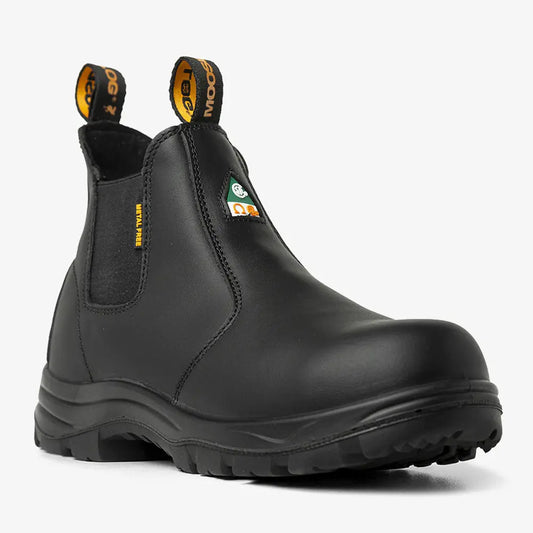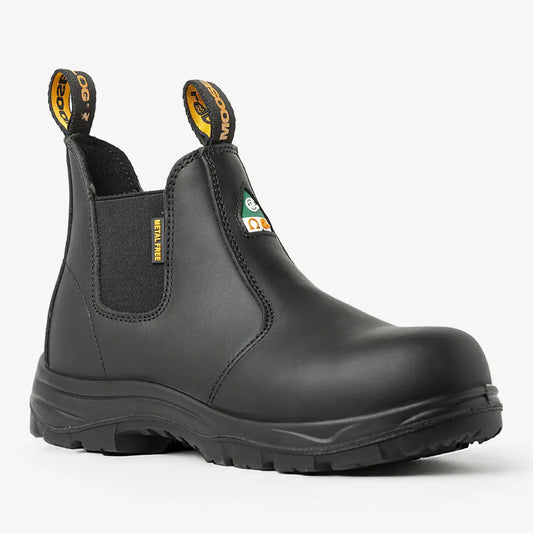
How Long Do CSA and ASTM Certified Boots Really Last?
If you rely on work boots every day, you know they take a beating. From construction sites to warehouses, your boots are the first line of defence against hazards. But even the toughest CSA or ASTM certified boots do not last forever. Many workers ask the same question: how long should my safety boots last before I need to replace them?
The answer depends on how you use them, the conditions you face, and how well you care for them. In this guide, we will break down the typical lifespan of certified safety boots, warning signs of wear, and practical tips to get the most out of your investment.
Average Lifespan of Certified Work Boots
On average, CSA and ASTM certified boots last between 6 to 12 months under daily heavy use. For lighter or occasional use, they may last up to 18 to 24 months.
- High-intensity jobsites (construction, mining, utilities): closer to 6–9 months.
- Moderate environments (warehousing, delivery, light trades): around 12 months.
- Occasional use (part-time work, inspections, emergency gear): up to 2 years.
According to the Canadian Centre for Occupational Health and Safety (CCOHS), the lifespan of safety footwear is influenced more by wear and tear than by time alone. Once structural integrity is compromised, certifications like CSA Z195 or ASTM F2413 no longer guarantee protection.
Factors That Shorten Boot Lifespan
1. Jobsite Conditions
Concrete, gravel, mud, and chemicals each wear down boots differently. Slip-resistant outsoles can smooth out faster on rough surfaces, while leather can crack in wet environments if not properly maintained.
2. Exposure to Elements
Moisture, extreme heat, or freezing conditions speed up breakdown. Salt and de-icers can damage leather and seams if not cleaned off.
3. Frequency of Use
A boot worn 8–12 hours a day will show fatigue twice as fast as a boot used a few times a week.
4. Maintenance Habits
Workers who regularly clean, dry, and condition their boots often double their lifespan compared to those who neglect them.
Signs It’s Time to Replace Your Safety Boots

Even if boots look intact, certifications lose meaning when key components fail. Watch for:
- Damaged toe caps – dents, cracks, or exposure of the composite or steel.
- Worn outsoles – loss of slip resistance, flat tread, or cracking rubber.
- Separation at seams – water leaks or reduced puncture resistance.
- Insole breakdown – loss of cushioning that causes foot pain and fatigue.
- Certification marks fading – CSA triangle or ASTM label no longer visible.
Employers and inspectors can consider boots non-compliant if markings are illegible or features are clearly compromised.
Tips to Extend the Life of Your Work Boots
Rotate Pairs
If possible, own two pairs and alternate them. This gives each pair time to dry fully between shifts.
Dry Properly
Never leave boots on a direct heat source. Use boot dryers or stuff with newspaper to wick away moisture.
Clean Regularly
Wipe mud, salt, and debris after each shift. Apply leather conditioner every few weeks to prevent cracking.
Use Insoles Wisely
Replace insoles every few months. Fresh insoles reduce odour, improve comfort, and prevent premature lining wear.
Store Smart
Keep boots in a dry, ventilated place when not in use. Avoid leaving them in hot vehicles or damp lockers.
Why Boot Lifespan Matters for Safety
Certified boots are not just footwear; they are personal protective equipment (PPE). Once they lose their protective features, your feet are at risk. More importantly, workplace safety regulations in Canada and the United States require workers to wear boots that meet CSA or ASTM standards. Wearing worn-out boots can make you non-compliant and liable in the event of an accident.
Conclusion
The lifespan of CSA and ASTM certified boots is not fixed, but most workers can expect between 6 months and 1 year of heavy daily use. With proper care, you may stretch that to 18 months or more. The key is knowing when to replace your boots and treating them as safety gear, not just shoes.
If you are looking for long-lasting protection, explore MooseLog’s CSA and ASTM certified composite toe boots designed for Canadian and U.S. workers. Built with lightweight materials, slip-resistant outsoles, and durable construction, MooseLog boots are engineered to stand up to tough conditions while keeping you compliant.
Related Blogs
- Do All Jobsites Require CSA/ASTM Boots?
- ASTM vs CSA Boots: Which One Do You Need?
- What to Look for in a CSA/ASTM Certified Work Boot (Without Overpaying)
FAQ
1. How often should I replace CSA or ASTM boots?
Most workers replace them every 6–12 months, depending on wear.
2. Can I still wear boots if the CSA or ASTM label fades?
No. Visible markings are required for compliance and inspections.
3. What is the biggest factor in boot lifespan?
Daily wear intensity and maintenance habits matter most.
4. Do composite toe boots last longer than steel toe?
Not necessarily; lifespan depends more on usage and care than toe material.
5. Can I repair safety boots instead of replacing them?
Minor repairs like stitching are fine, but once toe caps, outsoles, or plates are damaged, replacement is required.




